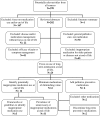Preventive medication use among persons with limited life expectancy
- PMID: 21731193
- PMCID: PMC3118532
- DOI: 10.1179/174329111X576698
Preventive medication use among persons with limited life expectancy
Abstract
Persons with limited life expectancy (LLE) - less than 1 year - are significant consumers of health care, are at increased risk of polypharmacy and adverse drug events, and have dynamic health statuses. Therefore, medication use among this population must be appropriate and regularly evaluated. The objective of this review is to assess the current state of knowledge and clinical practice presented in the literature regarding preventive medication use among persons with LLE. We searched Medline, Embase, and CINAHL using Medical Subject Headings. Broad searches were first conducted using the terms 'terminal care or therapy' or 'advanced disease' and 'polypharmacy' or 'inappropriate medication' or 'preventive medicine', followed by more specific searches using the terms 'statins' or 'anti-hypertensives' or 'bisphosphonates' or 'laxatives' and 'terminal care'. Frameworks to assess appropriate versus inappropriate medications for persons with LLE, and the prevalence of potentially inappropriate medication use among this population, are presented. A considerable proportion of individuals with a known terminal condition continue to take chronic disease preventive medications until death despite questionable benefit. The addition of palliative preventive medications is advised. There is an indication that as death approaches the shift from a curative to palliative goal of care translates into a shift in medication use. This literature review is a first step towards improving medication use and decreasing polypharmacy in persons at the end of life. There is a need to develop consensus criteria to assess appropriate versus inappropriate medication use, specifically for individuals at the end of life.
Figures


References
-
- Vollrath AM, Sinclair C, Hallenbeck J. Discontinuing cardiovascular medications at the end of life: lipid-lowering agents. J Palliat Med 2005;8(4):876–881 - PubMed
-
- Holmes HM, Hayley DC, Alexander GC, Sachs GA. Reconsidering medication appropriateness for patients late in life. Arch Intern Med 2006;166(6):605–609 - PubMed
-
- Riechelmann RP, Zimmermann C, Chin SN, Wang L, O'Carroll A, Zarinehbaf S, et al. Potential drug interactions in cancer patients receiving supportive care exclusively. J Pain Symptom Manage 2008;35(5):535–543 - PubMed
-
- Geelhoed RJ, Phillips JC, Fischer AR, Shpungin E, Gong Y. Authorship decision making: an empirical investigation. Ethics Behav 2007;17(2):95–115
Grants and funding
LinkOut - more resources
Full Text Sources
